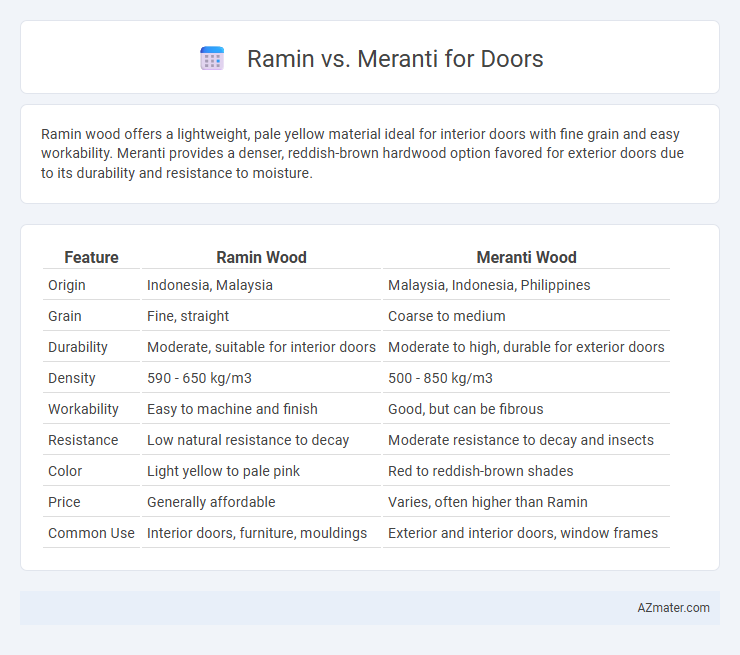Ramin wood offers a lightweight, pale yellow material ideal for interior doors with fine grain and easy workability. Meranti provides a denser, reddish-brown hardwood option favored for exterior doors due to its durability and resistance to moisture.
Table of Comparison
| Feature | Ramin Wood | Meranti Wood |
|---|---|---|
| Origin | Indonesia, Malaysia | Malaysia, Indonesia, Philippines |
| Grain | Fine, straight | Coarse to medium |
| Durability | Moderate, suitable for interior doors | Moderate to high, durable for exterior doors |
| Density | 590 - 650 kg/m3 | 500 - 850 kg/m3 |
| Workability | Easy to machine and finish | Good, but can be fibrous |
| Resistance | Low natural resistance to decay | Moderate resistance to decay and insects |
| Color | Light yellow to pale pink | Red to reddish-brown shades |
| Price | Generally affordable | Varies, often higher than Ramin |
| Common Use | Interior doors, furniture, mouldings | Exterior and interior doors, window frames |
Introduction: Ramin vs Meranti for Door Construction
Ramin and Meranti are two popular hardwoods commonly used in door construction, each offering distinct characteristics in terms of durability, grain, and cost. Ramin is known for its light color, fine texture, and ease of finishing, making it ideal for interior doors requiring smooth surfaces. Meranti, available in various color grades, provides stronger resistance to moisture and wear, often preferred for exterior doors and environments demanding greater robustness.
Wood Origin and Botanical Differences
Ramin wood, sourced primarily from Southeast Asia's Melaleuca and Gonystylus tree species, exhibits a fine, even grain with a smooth texture, making it ideal for intricate door designs. Meranti, derived from various Shorea species native to the tropical rainforests of Malaysia and Indonesia, features a coarser grain and a slightly reddish to brown hue, offering a more robust aesthetic for door construction. The botanical distinction lies in Ramin belonging to the Thymelaeaceae family, while Meranti is part of the Dipterocarpaceae family, influencing their durability, density, and workability in wood applications.
Physical Properties: Strength and Durability
Ramin wood offers moderate strength and good workability but has lower durability compared to Meranti. Meranti, known for its superior hardness and resistance to wear, provides enhanced strength and long-lasting durability, making it ideal for heavy-use doors. Both woods resist decay to some extent, but Meranti's higher density and natural oils contribute to better performance in demanding environments.
Appearance: Color, Grain, and Texture
Ramin wood features a light cream to pale yellow color with a fine, even grain and a smooth texture, making it ideal for doors requiring a clean and uniform appearance. Meranti offers a wider color range from light pinkish-brown to dark reddish-brown with a more pronounced, interlocking grain and a slightly coarse texture, lending a richer and more varied aesthetic. Both woods are popular for door manufacturing, but Ramin's consistent color and texture suit minimalist designs, while Meranti provides warmth and visual complexity.
Workability and Ease of Installation
Ramin wood offers superior workability compared to Meranti, featuring a fine and even texture that allows for smooth cutting, shaping, and sanding, making it ideal for intricate door designs. Meranti, while durable and strong, tends to have a coarser grain which can complicate detailed workmanship and slightly increase installation time. The ease of installation is higher with Ramin doors due to its consistent density and reduced likelihood of splitting or splintering during assembly and mounting.
Resistance to Termites and Weather Conditions
Ramin wood exhibits moderate resistance to termites and performs adequately under varying weather conditions, making it suitable for indoor door applications but requiring protective treatments for exterior use. Meranti wood offers higher natural resistance to termite attacks and demonstrates superior durability against harsh weather, providing better long-term performance for exterior doors. Both woods benefit from proper sealing and maintenance to enhance their resistance and longevity in door installations.
Cost Comparison: Ramin vs Meranti Doors
Ramin doors generally cost less than Meranti doors due to the faster growth rate and higher availability of Ramin timber, making it a more budget-friendly option for interior door applications. Meranti doors, prized for their rich color and durability, tend to be more expensive, reflecting their premium quality and longer harvesting period. Choosing between Ramin and Meranti for doors involves balancing cost considerations with desired aesthetic and performance characteristics.
Environmental Impact and Sustainability
Ramin wood, sourced from Southeast Asian tropical forests, faces significant environmental concerns due to illegal logging and habitat loss, making its sustainability status questionable. Meranti, derived mainly from sustainably managed plantations and certified sources, offers a more eco-friendly option with better forest management practices. Choosing Meranti over Ramin reduces deforestation risks and supports long-term biodiversity conservation in door manufacturing.
Best Use Cases for Ramin and Meranti Doors
Ramin doors are ideal for interior applications due to their smooth texture, lightweight, and easy workability, making them perfect for furniture, cabinetry, and molded door panels. Meranti doors excel in exterior and heavy-duty uses because of their durability, resistance to weather, and robustness, which suit them well for main entrance doors and frames exposed to harsh environmental conditions. Choosing Ramin ensures finer detailing and concise finish inside, while Meranti offers long-lasting performance and strength for outdoor or high-traffic door installations.
Conclusion: Which Wood is Better for Doors?
Meranti wood offers superior durability and resistance to moisture, making it an excellent choice for exterior doors exposed to varying weather conditions. Ramin, while lighter and easier to work with, lacks the same level of hardness and weather resistance, limiting its use primarily to interior doors. For long-lasting, sturdy, and weather-resistant doors, Meranti is the better wood option.

Infographic: Ramin vs Meranti for Door
 azmater.com
azmater.com